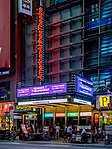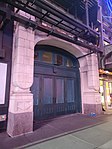Lyric Theatre (New York City, 1998)

The Lyric Theatre (previously known as the Ford Center for the Performing Arts, the Hilton Theatre, and the Foxwoods Theatre) is a Broadway theater at 214 West 43rd Street in the Theater District of Midtown Manhattan in New York City. Opened in 1998, the theater was designed by Richard Lewis Blinder of Beyer Blinder Belle, in collaboration with Peter Kofman, for Garth Drabinsky and his company Livent. The Lyric Theatre was built using parts of two former theaters on the site: the Apollo Theatre, built in 1920 to a design by Eugene De Rosa, and the old Lyric Theatre, built in 1903 to a design by Victor Hugo Koehler. The theater contains 1,622 seats across three levels and is operated by Ambassador Theatre Group (ATG). Despite having the same name as one of its predecessor theaters, the current Lyric Theatre was built almost entirely from scratch, though many parts of the old theaters were preserved to comply with government regulations. The current theater retains the original Lyric facade on 43rd Street, as well as a smaller arched facade on 42nd Street. The auditorium and stage house are placed within an entirely new structure covered with concrete and brick panels. The lobby contains a domed rotunda, with a basement lounge underneath it. The auditorium contains elements from the old Lyric's and the Apollo's interiors, including a ceiling dome, boxes, and a proscenium arch, which were modified to fit the new theater's dimensions. The large stage and the accompanying stage house were designed to accommodate major musicals. The old Lyric and Apollo theaters had been proposed for redevelopment since the 1970s, and New 42nd Street took over the theaters in 1990. Livent leased the theaters in 1995, razing them to make way for an 1,821-seat facility named after sponsor Ford Motor Company. The Ford Center was dedicated in December 1997 and officially opened the next month. Livent filed for bankruptcy in late 1998, and the theater subsequently passed to SFX Entertainment and then Clear Channel Entertainment, which renamed it for sponsor Hilton Hotels & Resorts in 2005. The venue was renamed after Foxwoods Resort Casino in 2010 as part of a partnership with Live Nation. ATG acquired the theater in 2013 and renamed it the Lyric the following year. The Lyric's capacity was reduced in a 2017 renovation because of complaints about the theater's excessive size, which had caused several of the theater's productions to lose money.
Excerpt from the Wikipedia article Lyric Theatre (New York City, 1998) (License: CC BY-SA 3.0, Authors, Images).Lyric Theatre (New York City, 1998)
West 43rd Street, New York Manhattan
Geographical coordinates (GPS) Address Nearby Places Show on map
Geographical coordinates (GPS)
| Latitude | Longitude |
|---|---|
| N 40.756944444444 ° | E -73.987777777778 ° |
Address
West 43rd Street 228
10036 New York, Manhattan
New York, United States
Open on Google Maps











